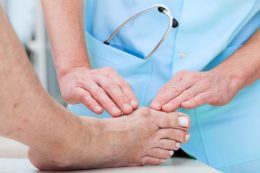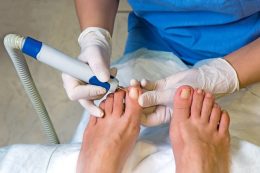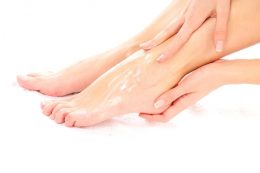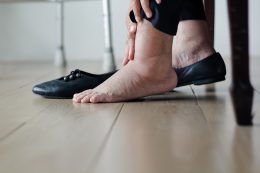Filed under Uncategorized …
Tips for Reducing Risks of Plantar Warts
Plantar warts are skin growths that develop on the soles of the feet, typically on the heels and under the toes, which are the areas more prone to pressure. They are caused by the human papillomavirus (HPV) that enters the skin through tiny cuts or scrapes. Anyone can develop this foot problem, but those who are most at risk include children, teenagers, and immunocompromised individuals.
Besides causing pain and discomfort, plantar warts may also alter the way you stand and walk if it’s left untreated for an extended period. In some severe cases, you may even have to get plantar wart treatment. To reduce your risks of developing these warts, read on for some helpful tips.
Never Walk Around Barefoot
The virus that causes plantar warts may spread on various surfaces, especially in public places. So, always wear the proper footwear when you’re outside. It also grows in warm, moist areas, so it’s crucial to wear slippers or sandals if you’re heading to the gym or locker rooms. Doing this also prevents the possibility of getting any foot injuries that may allow the HPV virus to penetrate the skin and cause plantar warts.
Do Not Touch and Pick at the Warts
If you or someone you know already have warts, refrain from touching or picking at them with your bare hands. Aside from possibly spreading them to the other parts of your body, you may also put more people at risk of developing this foot condition. If you must touch your plantar warts, remember to wash your hands thoroughly with soap before and after getting in contact with them.
Keep Your Feet Clean and Dry
Proper foot hygiene helps reduce the risk of developing plantar warts. So, wash your feet regularly with disinfecting soap and dry them well afterwards. If you’re wearing socks, change them multiple times a day to prevent the buildup of sweat and oils that may cause fungal infections.
Leaving your feet damp throughout the day allows more foot problems to develop, such as blisters and abrasions. When this happens, viruses may enter your foot more easily, putting you at risk of plantar warts.
Talk to a Trusted Foot Doctor
Now that you know about these precautions, you can reduce your risks of developing plantar warts. While they may be common and treatable, there are some instances where warts might require more comprehensive treatments. If you’re looking for plantar warts treatment in Salisbury, MD, reach out to our experts at Thomas Podiatry & Associates.
What You Need to Know About Bunions
Bunions are a common foot problem. They are a type of deformity that happens when the big toe pushes towards the other toes of the feet, causing a misalignment. This results in the formation of a bony bump on the joint at the base of your big toe.
This foot condition may cause limited movement and extreme pain, so it’s crucial to get bunion treatment after diagnosis. Read on to learn more about bunions and determine whether you are at risk of this foot problem.
What Causes Bunions?
Various factors cause bunions. They include pressure from faulty foot mechanics and foot stress or injury. Inherited foot structures, like having low arches or flat feet, also put you at risk of developing this condition. Besides that, those who have rheumatoid arthritis are more likely to develop bunions.
What Are the Symptoms of Bunions?
One of the most noticeable symptoms is the bump that forms at the side of your big toe. Besides the difficulty in fitting footwear, you may also feel pain, swelling, soreness, and numbness in the feet. Corns and calluses may also grow since the toes tend to rub against each other because of your foot’s misalignment.
Bunions develop gradually and can worsen over time. Standing for long periods and wearing ill-fitting shoes are some factors that can worsen its symptoms.
How Are Bunions Treated?
Various treatments help manage and remedy bunions, depending on your condition. Some non-invasive procedures include medication, footwear modification, taping and padding, orthotic devices, and physical therapy.
If these don’t work and your condition becomes severe, your foot doctor may recommend surgery. You will need to undergo an operation where the bunion is removed, and your bones are realigned to their correct positions.
Contact Thomas Podiatry & Associates
Bunions, if not treated right away, can lead to more serious complications. They include bursitis, where the bursa that cushions the bones near your joints becomes inflamed, and metatarsalgia, which causes pain and swelling in the ball of the foot. So, if you notice early signs, talk to a foot doctor right away. For reliable bunion treatment in Salisbury, MD reach out to Thomas Podiatry & Associates. Our team of experts will gladly assist you with your podiatric needs.
Ingrown Toenail Prevention: What You Need To Know
Ingrown toenails occur when the corner of the toenails grows into its surrounding skin. This condition usually affects the big toe and is characterized by symptoms such as swelling, pain and tenderness, or even an infection. Some causes of ingrown toenails include wearing tight footwear, cutting nails improperly, and injuring your toes.
Aside from causing discomfort, foot problems like ingrown toenails also affect daily routines. So, it’s best to learn how to prevent this foot condition. Here are some of them:
One of the best ways to prevent ingrown toenails is by trimming your nails the right way. Do this by cutting your nails straight across and at a length that is even with the tips of your toes. Shaping your toenails to be curved and trimming them too short will allow them to grow into the skin and cause ingrown toenails.
Wearing any kind of footwear that is too tight or too narrow may put unnecessary pressure on your toes, causing painful ingrown toenails. The risk of developing ingrown toenails, because of this, is higher for most teens since their feet are still growing. This is why it’s best to ensure your shoes have enough space for your feet to lie flat and for you to wiggle your toes.
Besides wearing well-fitting shoes, another way to prevent ingrown toenails is by protecting your feet from injuries. This is crucial for those who often participate in activities like running and sports since trauma to the toes causes ingrown toenails. So, make sure you wear the appropriate footwear should you engage in any physical activity that’ll put pressure on your toes.
Checking your feet allows you to look out for signs of ingrown toenails or other foot problems before they get worse. This is also helpful for people with diabetes who may experience numbness in the feet, preventing them from discovering injuries or foot conditions right away. If you notice anything unusual on your feet or toenails, consult a foot specialist immediately.
Consult a Podiatrist Near You
Learning about ingrown toenail prevention helps keep your feet healthy. If you see any signs of ingrown toenails or are unsure about the symptoms you’re feeling, talk to a foot doctor. Reach out to our experts at Thomas Podiatry & Associates in Salisbury, MD for more information about our services.
Diabetic Foot Care Tips To Keep Your Feet Healthy
Diabetes may cause various negative consequences on your feet. This is because diabetic neuropathy, the numbing of the feet, occurs when you have diabetes. Aside from that, diabetes also causes poor blood circulation, which prevents cuts or wounds on your feet from healing quickly, resulting in infections.
Because of this, ensuring the proper care of your feet is crucial. There are many ways you can keep them healthy and prevent potential foot complications. Here are some of them:
-
Inspect Your Feet Everyday
Since it’s common for people with diabetes to have numbness in their feet, it’s important to check for any signs of foot issues as much as you can. Always check your feet for cuts, swelling, blisters, redness, or any changes in your skin and nails. Doing so will help you address any diabetic foot problems and prevent them from worsening.
-
Always Wear Well-Fitting Shoes
Wearing shoes that are too big or too small may cause your feet to get squeezed or rubbed while wearing them. This may cause painful blisters, calluses, or bunions. So, it’s crucial to always get well-fitting footwear. You may also consider getting orthotic shoes to ensure you have the right-sized shoes.
-
Never Go Barefoot
As they say, prevention is better than cure. For that reason, protecting your feet by wearing shoes or socks all the time is essential. Doing so will prevent you from getting scrapes, scratches, or cuts without noticing since diabetes can numb the senses on your feet.
-
Keep Your Feet Dry and Moisturized
Whenever you wash your feet, it’s important to dry them completely afterwards, especially between the toes. This is because the skin there is airtight, and leaving them damp may lead to fungal infections. Since diabetes also causes dry skin, moisturizing your feet is essential. But be sure your skin is not wet or sticky, and avoid putting lotion between your toes.
Talk to a Reliable Podiatrist
For people who have diabetes, learning more about diabetic foot care helps prevent the risk of foot infections or non-healing wounds. If you have an existing condition or notice any unusual symptoms, it’s best to reach out to a foot doctor. Contact us at Thomas Podiatry & Associates in Salisbury, MD for details about our podiatric services.
Tips on Choosing a Sports Medicine Doctor
An active lifestyle that can be achieved through sports or regular workouts helps improve your health and overall wellbeing. Still, an accident and injury occur when we least expect it. When it happens, it’s best to consult a sports physician.
Aside from treating various injuries related to physical activities, sports medicine doctors also help prevent them. So, if you’re exercising regularly or planning to get back into sports, it might be best to reach out to them. Read on for some tips on choosing a sports medicine specialist:
- Ask for Referrals
- Check Credentials and Experience
- Bedside Manner and Comfort Level
One of the first things you should do is to get referrals. Reach out to your physician or other healthcare professionals you know for a list of their recommendations. Besides that, you may also ask friends and family who have already been treated by a sports medicine doctor. Doing so will guarantee reliable and concrete feedback about their services.
Like other medical professions, being a sports doctor involves possessing the right skills, knowledge, and training to give the best possible care to patients. So, checking their certifications, licensure, and other relevant credentials is crucial.
Aside from that, you should also look into their experience as a sports medicine professional. Are all their medical procedures successful? Was there an instance of malpractice throughout their year of working? This will ensure that the person you’re considering is qualified and trustworthy.
Discussing personal information and health issues that require tough decision-making can be difficult. So, choosing a sports physician whom you can be comfortable with and who is sensitive to your needs and worries is important.
Besides helping you communicate your concerns easily, considering these factors will also help you find a doctor who will best guide you through the treatment and recovery process. As a result, you will feel more at ease no matter the procedure.
Reach Out to Thomas Podiatry & Associates
Choosing the right sports medicine doctor will help you prevent injuries and get the treatment that best suits your needs. If you’re looking for a trusted sports medicine professional or a reliable podiatrist in Maryland, contact Thomas Podiatry & Associates in Salisbury, MD today. Our friendly staff will gladly assist you!
Types of Sports Injury Treatment
Sports injuries may happen because of various reasons. They include inadequate warm-up, overexertion, overuse, and improper use of equipment or sporting gear. Some of the most common injuries are sprains and strains, tendonitis, dislocations, and fractures.
No matter how mild or severe your injuries are, urgent treatment is essential to minimize damage and relieve pain. Plus, it will also prevent any further complications. Read on to learn about some treatments for sports injuries.
RICE Method
This is a common treatment for minor sports injuries that is done for the first 24 to 48 hours. The RICE method has four elements, namely: rest, ice, compression, and elevation. Doing these helps relieve pain and promote proper healing and recovery. Here’s what you should do:
- Rest – Avoid using the injured area or doing activities that put too much force on them. Besides causing discomfort, it may also slow down the healing process and worsen the injury.
- Ice – It helps reduce pain and swelling. Apply an ice pack or a bag of frozen peas on the affected area for 10-20 minutes, two to three times a day.
- Compression – Using compression bandages helps provide support and reduce swelling. Ensure that the bandages are wrapped snugly but not too tight to allow proper blood circulation.
- Elevation – You can further ease pain by elevating the injury as much as possible. Do this by propping the injured area with a pillow and keeping it at a level above the heart.
Immobilization Treatment
Another sports injury treatment is immobilization. It involves stabilizing the injury using casts, splints, slings, or braces to prevent it from worsening. Besides protecting the affected area, these medical devices also ease discomfort and swelling.
Physiotherapy
Depending on your injury, your doctor may also suggest physiotherapy. This treatment uses methods such as exercises, massages, and manual manipulation. They will help regain comfortable movement of joints and muscles and strengthen the surrounding muscles of the injured area.
Contact Thomas Podiatry & Associates
If you exercise or play sports regularly, learning about some treatments for injuries may be helpful. Despite that, if you experience severe pain or notice any obvious deformity from the affected area, call a sports injury doctor right away. Reach out to us at Thomas Podiatry & Associates in Salisbury, MD today to learn more about sports medicine.
A Guide to Diabetic Foot Amputation and Recovery
Will Diabetic Complications Require Foot Amputation?
Practicing good diabetes management and regular foot care is essential for preventing severe foot sores that are difficult to treat. Over 80% of diabetic foot amputations occur because of foot ulcers that do not heal. They can develop on any diabetic patient and should be addressed immediately – otherwise, you run the risk of needing an amputation. Here’s what you need to know about keeping your feet healthy and what happens if amputation is necessary.
Foot Ulcer Causes
Foot ulcers do not discriminate – anyone who has diabetes can develop one. Several factors can cause foot ulcers. Some of the causes can include a diminished sense of feeling in the foot, inadequate blood circulation in lower extremities, friction or pressure against the foot, or physical trauma.
The progression of diabetes over time may also lead to the formation of a foot ulcer. Some patients develop diabetic neuropathy, which reduces the sensation of touch. As a result, patients may not be aware of any damage they are causing to their feet. Diabetic neuropathy is easily detectable, so if you notice a lack of sense of touch in your foot, it is critical to make an appointment with a podiatrist right away.
Preventing Ulcers
You can significantly reduce the likelihood of developing a foot ulcer by following key practices that promote healthy feet. For instance, regularly inspecting your feet for any wounds or signs of bacteria and fungal infection is a great way to remain vigilant for warning signs.
You can also promote good hygiene by thoroughly washing and drying your feet at least once per day, with a focus on drying between the toes. Wearing clean socks and closed footwear every day, even around the house, can protect against any physical trauma to the foot.
Additionally, you can reduce the chances of foot ulcers by avoiding temperature-based treatments, such as heating pads. Monitoring and managing your blood pressure, controlling blood sugar with insulin, quitting smoking, and following a healthy diet can also bolster your efforts to prevent foot ulcers.
Foot Amputation Warning Signs for Diabetic Patients
It is crucial for those living with diabetes to pay extra attention to their feet because they are at higher risk of wounds not healing correctly. Some of the signs that you should look for include ingrown toenails, blisters, foul odors, plantar warts on the bottoms of your feet, and athlete’s foot, a scaly, itchy rash that causes pain.
Other symptoms may include swelling and/or redness, pain, or localized warmth in one part of your foot, indicating inflammation. You may also notice a large ulcer where the bone and muscle are visible that does not go away after a couple of weeks or show signs of progressive healing. If You notice any of these warning signs, be sure to contact your podiatrist immediately.
When is an Amputation Deemed Necessary?
An ulcer that does not heal and causes significant damage to your tissues and bone may require surgical removal or amputation. Usually, the first option is to treat the wound, remove the affected tissue, and monitor your progress. While some cases only require a partial amputation, others will necessitate the total removal of the foot. If an ulcer is life-threatening or has removed too much tissue from your foot, an amputation is usually necessary.
Who Performs the Amputation?
Whether your podiatrist will perform the amputation depends on if they are qualified to perform surgeries on the feet. If your foot doctor cannot complete the amputation, they will coordinate with qualified surgeons in their network whom they trust to provide you the best care possible. Other specialists, such as physical and endocrinologists, may also assist with your care before, during, and after an amputation.
While the thought of a diabetic foot amputation can be scary, forming diligent habits to care for your feet can increase the chances of prevention. You can help support healthy feet by working with a podiatrist who can assist you in managing and treating any warning signs. Doing so can considerably reduce the likelihood of developing an ulcer or damaging your foot due to numbness.
To learn more about diabetic foot treatments or to schedule an appointment with one of our caring physicians, get in touch with our office today. We look forward to helping you maintain healthy feet!












